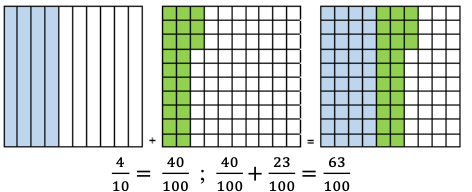General Information
Benchmark Instructional Guide
Connecting Benchmarks/Horizontal Alignment
Terms from the K-12 Glossary
- NA
Vertical Alignment
Previous Benchmarks
Next Benchmarks
Purpose and Instructional Strategies
The purpose of this benchmark is to connect fraction addition to decimal addition through decimal fractions. This will be the first opportunity for students to create common denominators to add fractions. This benchmark continues the work of equivalent fractions (MA.3.FR.1.2) by having students rename fractions with denominators of 10 as equivalent fractions with denominators of 100 (MA.4.FR.1.1). Students who can generate equivalent fractions can adapt this new procedure to develop strategies for adding fractions with unlike denominators in grade 5 (MA.5.FR.2.1).- Instruction may include students shading decimal grids (10 × 10 grids) to support their understanding.

- Subtraction of decimal fractions is not a requirement of grade 4.
Common Misconceptions or Errors
- Students often will add the numerators and the denominators without finding the like denominator. Students will need visual models to understand what the like denominator means.
Strategies to Support Tiered Instruction
- Instruction includes opportunities to explore the addition of a fraction with a denominator of 10 to a fraction with a denominator of 100 using visual models to help understand equivalent fractions. Students use visual models to make sense of equivalent fractions when finding like denominators. The teacher provides clarification that students must find the like denominator before adding.
- For example, the teacher displays the problem + and asks students to share what they notice about this expression. Students identify that the denominators are different. The teacher guides students to shade decimal grids to represent the understanding that is equivalent to . This is repeated with similar addition problems and solved while supporting students as they use the visual models to problems that have denominators of 10 and 100.

- For example, the teacher displays the problem + , asking students to share what they notice about this expression. Students identify that the denominators are different. The teacher guides students to use place value blocks and shaded decimal grids to represent the problem and solve, having tens rods represent tenths, and one's cubes represent hundredths. Students are supported as they use the visual models to understand that is equivalent to . This is repeated with similar addition problems that have denominators of 10 and 100.


Instructional Tasks
Instructional Task 1 (MTR.5.1)
Determine the equivalent fraction.- =
- + =
Instructional Items
Instructional Item 1
An expression is shown. What is the value of the expression?- +

 is equivalent to
is equivalent to  which is equivalent to
which is equivalent to  .
.